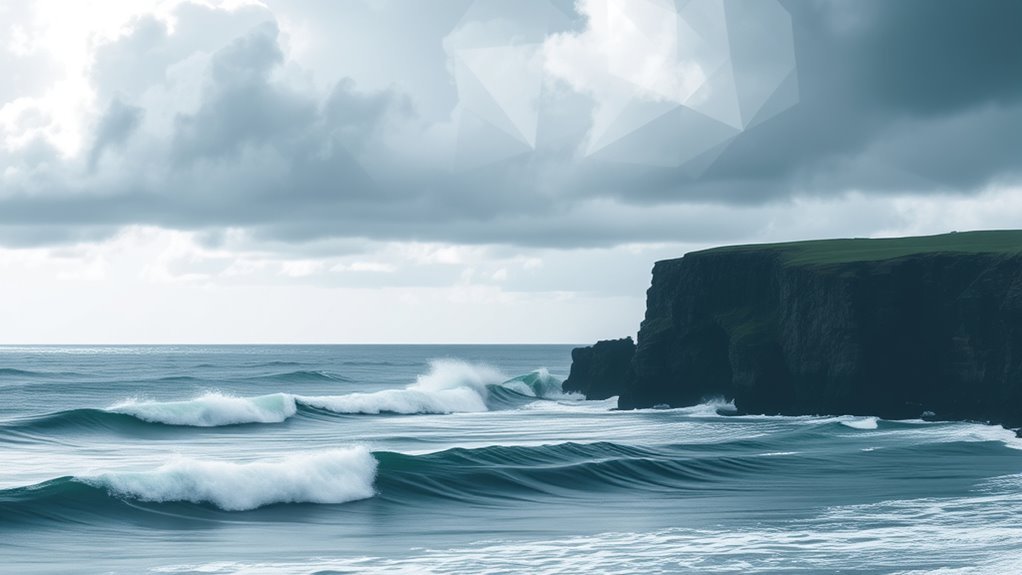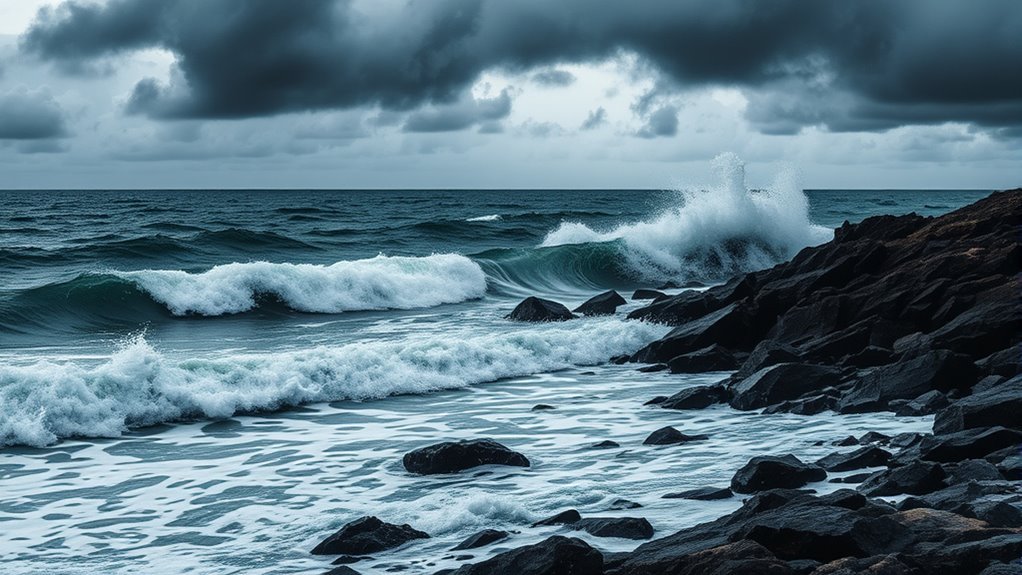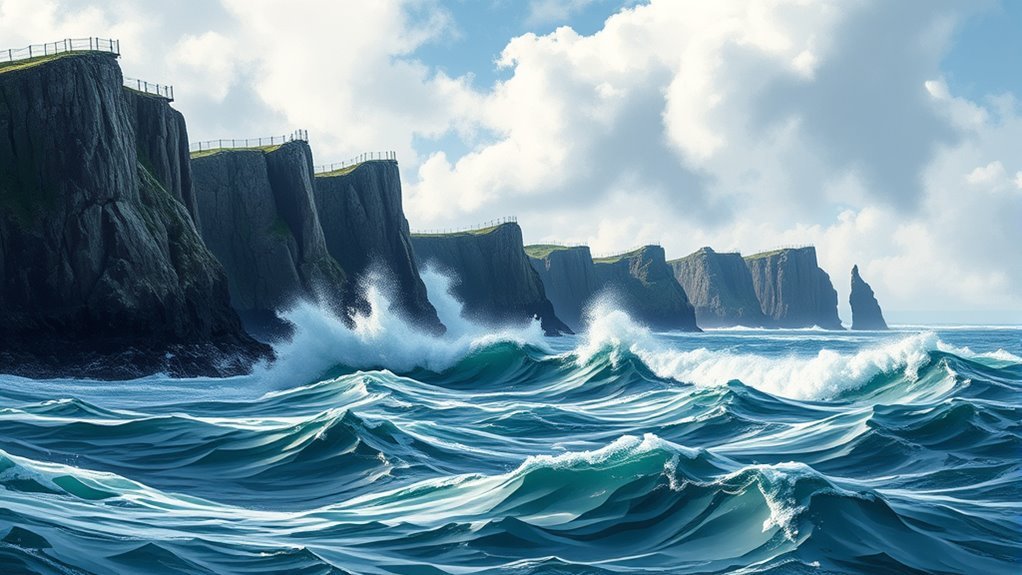Squalls are intense weather events that rapidly increase wind speed, leading to considerable changes in water levels. They form when cold air pushes into warmer air, resulting in turbulence and pressure shifts. These conditions can cause storm surges and flooding, particularly in coastal areas. With rising sea levels and increased squall intensity due to climate change, the risks associated with coastal flooding are amplified. Understanding the complexities of these interactions reveals further consequences for vulnerable communities.
Main Points
- Squalls generate rapid wind shifts that push water towards coastlines, leading to storm surges and elevated water levels.
- Abrupt changes in atmospheric pressure during squalls can displace water, causing localized rises in water levels.
- Strong winds associated with squalls create wave action, exacerbating coastal erosion and increasing flooding risks.
- Heavy rainfall from squalls can overwhelm drainage systems, contributing to surface flooding and rising water levels.
- The combination of wind, rainfall, and pressure changes during squalls significantly impacts water levels, particularly in coastal regions.
What Are Squalls and How Do They Form?
Although squalls can occur suddenly, they are defined by a rapid increase in wind speed and often accompany a storm front. These meteorological phenomena typically manifest as short-lived bursts of intense wind, which can be both powerful and unsettling.
Squalls form when cold, dense air pushes into a region occupied by warmer air, leading to turbulence and instability. As this colder air descends, it creates a localized area of low pressure, resulting in sharp wind shifts and increased gustiness.
The conditions that encourage squalls can arise in various environments, including coastal regions and areas prone to thunderstorms. Their duration is generally brief, lasting from minutes to a few hours, but the impact can be notable.
Sailors and outdoor enthusiasts are particularly cautious during squalls, as the sudden changes in wind can alter water conditions rapidly, posing risks to safety and navigation. Understanding their formation is vital for preparedness and risk management.
The Mechanics of Squalls and Water Level Changes

The mechanics of squalls involve a rapid change in atmospheric pressure, leading to strong winds and sudden rainfall.
This process greatly impacts water levels, as the influx of rainwater can cause rivers and lakes to rise quickly.
Understanding these dynamics is essential for predicting potential flooding and managing water resources effectively.
Squall Formation Process
When atmospheric conditions align, squalls can form rapidly, leading to sudden changes in water levels. This phenomenon typically occurs when warm, moist air rises quickly due to a cold front or a localized weather disturbance.
As the warm air ascends, it cools and condenses, forming cumulonimbus clouds. The resulting downdrafts can generate strong winds, often accompanied by heavy rainfall.
The interaction of these elements creates turbulence, which intensifies the squall's severity. The rapid change in wind direction and speed can lead to notable pressure differences, further enhancing the squall's intensity.
Additionally, coastal areas may experience abrupt shifts in water levels as the squall impacts surface currents, contributing to the general dynamics of the marine environment.
Impact on Water Levels
Squalls greatly influence water levels, particularly in coastal regions. The intense winds and rapid changes in atmospheric pressure associated with squalls can lead to notable alterations in sea levels.
As these storms pass, strong onshore winds can push water towards the shore, causing temporary rises in water levels, known as storm surges. Additionally, the abrupt shifts in pressure can create a phenomenon called "setup," where water is displaced and accumulates in specific areas. These changes can result in flooding, especially during high tide.
Conversely, as squalls dissipate, water levels may drop suddenly, leading to potential hazards for vessels and coastal infrastructure. Understanding these dynamics is essential for predicting and mitigating the impacts of squalls on water levels.
The Impact of Rising Sea Levels on Coastal Areas
Rising sea levels pose substantial challenges for coastal areas, leading to increased coastal erosion and heightened flooding risks.
These changes threaten not only human infrastructure but also disrupt local habitats, impacting wildlife and ecosystems.
As communities confront these issues, understanding the consequences becomes essential for effective planning and adjustment.
Coastal Erosion Challenges
As coastal regions grapple with the effects of climate change, the challenges of coastal erosion become increasingly pronounced. Rising sea levels, driven by melting ice caps and thermal expansion, exacerbate the vulnerability of shorelines. These factors contribute to the loss of land, threatening ecosystems and human settlements alike.
Storm surges, intensified by squalls, further accelerate erosion, leading to the degradation of beaches, cliffs, and wetlands. Coastal infrastructure, including homes and roads, faces heightened risk as natural barriers diminish.
Communities must confront the economic consequences of erosion, including decreased property values and increased costs for protective measures. Sustainable management practices, including the restoration of natural habitats, play a critical role in mitigating these challenges while enhancing resilience against future environmental changes.
Flooding Risk Increase
The increasing severity of coastal erosion, driven by climate change and storm surges, lays the groundwork for heightened flooding risks in coastal areas. As rising sea levels encroach upon shorelines, the frequency and intensity of flooding events escalate.
Communities situated near coastlines face considerable threats, as infrastructure and ecosystems become increasingly vulnerable. Storm surges, exacerbated by squalls, contribute to this dangerous terrain, overwhelming drainage systems and leading to prolonged inundation.
Furthermore, the unpredictability of extreme weather events complicates preparedness efforts, leaving coastal populations at risk. As a result, urban planners and policymakers must prioritize flexible strategies to mitigate flooding risks, ensuring the resilience of communities against the compounding effects of climate change and rising water levels.
Habitat Disruption Effects
While coastal ecosystems have long modified to periodic changes in water levels, the current trends in sea level rise threaten to disrupt these habitats considerably. Increased salinity can alter the composition of plant and animal species, leading to a decline in biodiversity.
Wetlands, essential for wildlife and water filtration, may be submerged, reducing their ability to combat flooding and absorb pollutants. Additionally, erosion of shorelines can result in habitat loss for nesting sites of birds and other species.
The encroachment of saltwater into freshwater systems further jeopardizes the health of aquatic life. As these ecosystems struggle to adjust, the cascading effects on local communities, fisheries, and overall coastal resilience become increasingly pronounced, highlighting the urgent need for adaptive management strategies.
Squalls and Their Role in Coastal Flooding Events

Squalls, defined by sudden and intense bursts of wind and precipitation, can greatly impact coastal areas, particularly during extreme weather events.
These weather phenomena often lead to rapid fluctuations in water levels, which can exacerbate flooding conditions. The strong winds associated with squalls can create notable wave action, causing coastal erosion and increasing the likelihood of inundation in low-lying areas.
In addition, the heavy rainfall that accompanies squalls can overwhelm drainage systems, leading to surface flooding and exacerbating the risk of storm surge during high tides. The combination of these factors can overwhelm natural and man-made barriers, resulting in extensive damage to infrastructure and ecosystems.
Moreover, the unpredictability of squalls presents challenges for forecasting and preparedness, making it essential for coastal communities to understand their potential impacts.
As climate change continues to influence weather patterns, the role of squalls in coastal flooding events will likely become increasingly critical.
Case Studies: Notable Squalls and Their Consequences

Analyzing notable squalls reveals their considerable consequences on coastal environments and communities. Historical instances underscore the intensity and unpredictability of these weather phenomena, illustrating their far-reaching impacts.
Three considerable case studies exemplify this:
- Hurricane Sandy (2012): This storm combined squall-like conditions with rising tides, leading to devastating flooding in New York and New Jersey, displacing thousands and causing billions in damages.
- Tropical Storm Alberto (2018): Though not classified as a hurricane, Alberto produced severe squalls, resulting in flash flooding across parts of Florida and the Carolinas, highlighting the risk even from less intense systems.
- Squall Line in the Mid-Atlantic (2020): This event generated intense rain and wind, leading to localized flooding and infrastructure damage, impacting small communities reliant on stable weather conditions.
These case studies emphasize the urgent need for awareness of squalls and their potential to disrupt coastal life.
Preparing Communities for Squall-Induced Flooding
As communities increasingly face the threat of squall-induced flooding, proactive measures become essential for minimizing impact. Local governments must prioritize the development and implementation of thorough emergency response plans that include clear evacuation routes and communication strategies.
Engaging community members through educational initiatives can improve awareness of squall risks and encourage preparedness.
Infrastructure improvements, such as reinforcing drainage systems and constructing barriers, can greatly mitigate flooding effects. Additionally, investing in early warning systems allows residents to receive timely alerts about impending squalls, enabling them to take necessary precautions.
Collaboration with local organizations and stakeholders can cultivate resilience, ensuring that resources are allocated effectively. Regular drills and community meetings can further strengthen the collective response to flooding events.
Future Projections: Squalls in a Changing Climate
The ongoing impacts of climate change are expected to greatly alter the frequency and intensity of squalls, posing new challenges for communities already grappling with flooding risks.
As atmospheric temperatures rise, changes in weather patterns will likely lead to:
- Increased Squall Frequency: More frequent squalls may occur, resulting in heightened flooding risks for coastal and low-lying areas.
- Enhanced Intensity: The intensity of squalls is projected to increase, causing stronger winds and heavier rainfall, which can overwhelm drainage systems.
- Wider Geographic Spread: Squalls may impact regions previously less affected, forcing communities to adjust to new weather extremes.
These projections necessitate that local governments and residents prepare for the potential repercussions of intensified squalls.
Proactive measures, such as improved infrastructure and emergency response plans, will be essential to mitigate the risks associated with these changing weather phenomena.
Common Questions
How Can I Stay Safe During a Squall Event?
During a squall event, individuals should seek shelter indoors, avoid windows, secure loose objects, and stay informed through weather updates. Staying calm and prepared improves safety amidst the unpredictable nature of rapidly changing weather conditions.
What Is the Difference Between a Squall and a Storm?
A squall is a sudden, intense burst of wind and rain, typically short-lived, while a storm is a broader term including various weather phenomena, including prolonged heavy precipitation, thunder, lightning, and sustained high winds.
Can Squalls Occur in Inland Areas?
Squalls can indeed occur in inland areas, typically forming due to localized atmospheric conditions. Their intensity can vary, but they often bring sudden gusts of wind and brief periods of heavy rain, impacting local weather patterns considerably.
How Do Squalls Affect Marine Life?
Squalls can considerably impact marine life by disrupting feeding patterns, displacing species, and altering water temperature. The turbulent conditions created by squalls can also affect breeding habits and the availability of nutrients in the water.
Are Squalls More Common in Certain Seasons?
Squalls tend to be more common during specific seasons, particularly late spring and summer. Warm air masses colliding with cooler ones create the ideal conditions for these sudden weather events, leading to increased frequency during those times.

